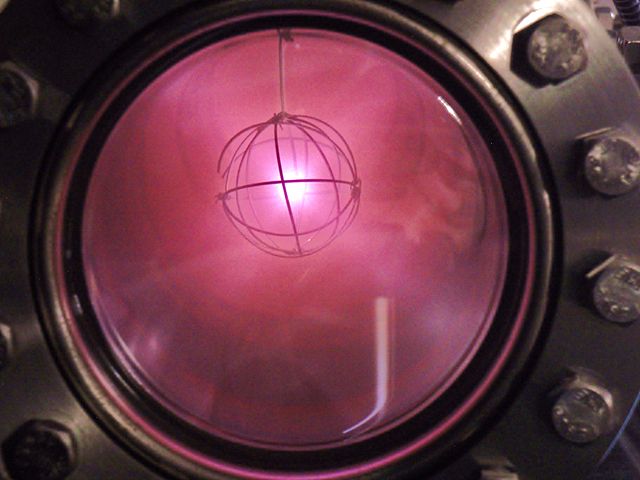Nuclear fusion is a reaction in which two or more atomic nuclei, usually deuterium and tritium, combine to form one or more different atomic nuclei and subatomic particles. The difference in mass between the reactants and products is manifested as either the release or absorption of energy. This difference in mass arises due to the difference in nuclear binding energy between the atomic nuclei before and after the reaction. Nuclear fusion is the process that powers active or main-sequence stars and other high-magnitude stars, where large amounts of energy are released.
The Sun is a main-sequence star, and thus releases its energy by nuclear fusion of hydrogen nuclei into helium. In its core, the Sun fuses 500 million tonnes of hydrogen each second.
The Tokamak à configuration variable, research fusion reactor, at the École Polytechnique Fédérale de Lausanne (Switzerland).
Deuterium (hydrogen-2, symbol 2H or D, also known as heavy hydrogen) is one of two stable isotopes of hydrogen (the other is protium, or hydrogen-1). The deuterium nucleus, called a deuteron, contains one proton and one neutron, whereas the far more common protium has no neutrons in the nucleus. Deuterium has a natural abundance in Earth's oceans of about one atom of deuterium among every 6,420 atoms of hydrogen (see heavy water). Thus deuterium accounts for about 0.0156% by number (0.0312% by mass) of all hydrogen in the oceans: 4.85×1013 tonnes of deuterium – mainly in form of HOD (or 1HO2H or 1H2HO) and only rarely in form of D2O (or 2H2O) – in 1.4×1018 tonnes of water. The abundance of deuterium changes slightly from one kind of natural water to another (see Vienna Standard Mean Ocean Water).
Deuterium discharge tube
Ionized deuterium in a fusor reactor giving off its characteristic pinkish-red glow
Harold Urey, deuterium's discoverer
The "Sausage" device casing of the Ivy Mike H bomb, attached to instrumentation and cryogenic equipment. The 20-ft-tall bomb held a cryogenic Dewar flask with room for 160 kg of liquid deuterium.






